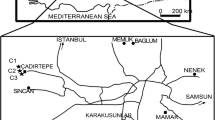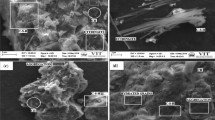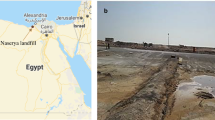Abstract
Clay-bearing Upper Pliocene red clastics and Quaternary alluvial deposits occupy the Ankara basin. The clayey levels of the Upper Pliocene deposits, referred to as Ankara clay, is considered as a source for compacted clay liners due to their low coefficients of permeability and widespread distributions throughout Ankara. This study investigates the geological, geotechnical and mineralogical properties of the founding clayey soils at two sites of the Ankara region. The geotechnical index properties along with the hydraulic conductivities of the clayey soil samples collected from these sites were determined. A mathematical relation between the clay mineralogical content and hydraulic conductivity was established. The results of this investigation show that, from a geotechnical point of view, Ankara clay may be regarded as a highly suitable material for a compacted clay landfill liner given that its mineralogical compatibility with leachate is confirmed.














Similar content being viewed by others
References
Acar Y, Oliveri I (1990) Pore fluid effects on the fabric and hydraulic conductivity of laboratory-compacted clay. Transportation Research Record 1219. Transportation Record Board, 144–159
ASTM D422–63 (2002) Standard test methods for particle-size analysis of soils. Annual Book of ASTM Standards, Section 4, Vol. 04.08, Soil and Rock; Building Stones. ASTM, Philadelphia
ASTM D698–00 Standard test methods for laboratory compaction characteristics of soil using standard effort (12,400 ft-Ibf/ft3 (600kN-m/m3)). Annual Book of ASTM Standards, Section 4, Vol. 04.08, Soil and Rock; Building Stones. ASTM, Philadelphia
ASTM D854–02 Standard test methods for specific gravity of soils. Annual Book of ASTM Standards, Section 4, Vol. 04.08, Soil and Rock; Building Stones. ASTM, Philadelphia
ASTM D2487–00 Standard classification of soils for engineering purposes (Unified Soil Classification System). Annual Book of ASTM Standards, Section 4, Vol. 04.08, Soil and Rock; Building Stones. ASTM, Philadelphia
ASTM D4318–00 Standard test methods for liquid limit, plasticity limit, and plasticity index of soils. Annual Book of ASTM Standards, Section 4, Vol. 04.08, Soil and Rock; Building Stones. ASTM, Philadelphia
ASTM D5856–95 (2002) Standard test methods for measurement of hydraulic conductivity of porous material using a rigid-wall, compaction-mold permeameter. Annual Book of ASTM Standards, Section 4, Vol. 04.08, Soil and Rock; Building Stones, ASTM, Philadelphia
Benson C, Daniel D (1990) Influence of clods on hydraulic conductivity of compacted clay. Journal of Geotechnical Engineering, ASCE 116:1,231–1,248
Benson C, Zhai H, Wang X (1994) Estimating the hydraulic conductivity of compacted clay liners. Journal of Geotechnical Engineering, ASCE 120:366–387
Birand AA (1963) Study characteristics of Ankara clays showing swelling properties. MSc. Thesis, Middle East Technical University, Department of Civil Engineering, Ankara, 39 p (unpublished).
Brindley GW, Kurtossy SS (1961) Quantitative determination of kaolinite by XRD. American Mineralogist 46:1,205–1,215
Çokça E (1991) Swelling potential of expansive soils with a critical appraisal of the identification of swelling of Ankara soils by methylene blue tests. Ph.D. thesis, Middle East Technical University, Department of Civil Engineering, Ankara, 323 pp (unpublished)
Çokça E (2000) An overview of the 35 years of research on the volume change behavior of Ankara soils. Middle East Technical University, Department of Civil Engineering, Ankara, 35 pp
Daniel D (1987) Earthen liners for land disposal facilities. In Geotechnical Practice for Waste Disposal ‘87, GSP No. 13, ASCE, 21–39
Daniel D (1990) Summary review of construction quality control for earthen liners. In: Bonaparte R (ed), Waste Containment Systems: Construction, Regulation, and Performance, GSP No.26, ASCE, 175–189
Daniel D, Benson C (1990) Water content-density criteria for compacted soil liners. Journal of Geotechnical Engineering, ASCE 116:1,811–1,830
D’Appolonia D (1980) Soil-bentonite slurry trench cutoffs. Journal of Geotechnical Engineering, ASCE 106:399–417
Garcia-Bengochea I, Lovell C, Altschaeffl A (1979) Pore distribution and permeability of silty clays. Journal of Geotechnical Engineering Division, ASCE 105:839–856
Kayabali K, Mollamahmutoğlu M (2000) The influence of hazardous liquid waste on the permeability of earthen liners. Environmental Geology 39(3–4): 201–210
Kenney T, Veen M, Swallow M, Sungaila M (1992) Hydraulic conductivity of compacted bentonite-sand mixtures. Canadian Geotechnical Journal 29:364–374
Koçyiğit A, Türkmenoğlu AG (1991) Geology and mineralogy of the so-called “Ankara clay” formation: A geologic approach to the “Ankara clay” problem. In: Zor M (ed), Vth National Clay Symposium, September 16–20, Eskişehir Anadolu University, 87–101 (in Turkish)
Lambe T (1954) The permeability of compacted bentonite fine-grained soils. Special Technical Publication No. 163, ASTM. Philadelphia, 56–67
Mesri G, Olson R (1971) Mechanisims controlling the permeability of clays. Clays and Clay Mineralogy, 19:151–158
Met İ (1999) Engineering geological assessment of clayey soils in Ankara for being utilized as compacted clay liners. MSc thesis, Middle East Technical University, Department of Geological Engineering, Ankara, Turkey, 151 pp
Met İ, Akgün H (1998) Utilization of Ankara clay as a compacted clay liner. In: Third International Turkish Geology Symposium Abstracts, August 31-September 4, Middle East Technical University, Ankara, Turkey, p 46
Mitchell J, Hooper D, Campanella R (1965) Permeability of compacted clay. Journal of Soil Mechanics and Foundation Division, ASCE 91:41–65
Ordemir I, Alyanak I, Birand AA (1965) Report on Ankara clay. Middle East Technical University, Engineering Faculty, Ankara, No. 12, 27 pp
Resmi Gazete (1991) Solid waste control regulation. Resmi Gazete, pp 4–19 (in Turkish)
Rowe RK, Quigley RM, Booker JR (1995) Clayey barrier systems for waste disposal facilities. E&FN Spon, London
Tchobanoglous G, Theisen H, Vigil S (1993) Integrated soil waste management. McGraw-Hill, New York
USEPA (1993) Criteria for municipal solid waste landfills (MSWLF Criteria), 40 CFR, Part 258, Cincinnati, Ohio
Verhoef PNW (1992) The methylene blue adsorption tests applied to geometarials. Memoriors of the Center of Engineering Geology in Netherlands, Delft University of Technology, 101, GEOMAT.02, 70 pp
Acknowledgments
This work is supported by the Middle East Technical University (METU) Research Fund Project No. AFP-97–03–09–01. Thanks are due to Dr. A. P. Őnen, Mr. Ő. Aktürk and Mr. U. Demirtaş of the Middle East Technical University, Department of Geological Engineering, Ankara, Turkey for their kind assistance in re-drafting the illustrations in this manuscript.
Author information
Authors and Affiliations
Corresponding author
Rights and permissions
About this article
Cite this article
Met, İ., Akgün, H. & Türkmenoğlu, A.G. Environmental geological and geotechnical investigations related to the potential use of Ankara clay as a compacted landfill liner material, Turkey. Env Geol 47, 225–236 (2005). https://doi.org/10.1007/s00254-004-1147-4
Received:
Accepted:
Published:
Issue Date:
DOI: https://doi.org/10.1007/s00254-004-1147-4




